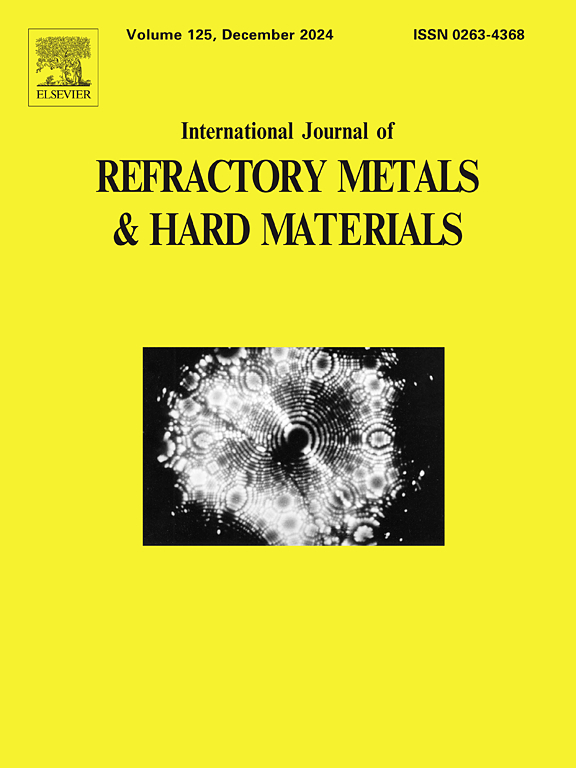Effect of heat treatment on microstructure and mechanical properties of tantalum by selective laser metal
IF 4.2
2区 材料科学
Q2 MATERIALS SCIENCE, MULTIDISCIPLINARY
International Journal of Refractory Metals & Hard Materials
Pub Date : 2025-03-22
DOI:10.1016/j.ijrmhm.2025.107125
引用次数: 0
Abstract
Improving the mechanical properties of selective laser–melted pure tantalum (SLMed Ta), a new-generation orthopedic implant material, is of paramount importance. Appropriate annealing parameters directly affect the microstructure and macromechanical properties of SLMed Ta, thereby making them a focal point in the research on this material. This study conducted a gradient crossover experiment to elucidate the effects of three annealing temperature ranges and holding times on the grain morphology and mechanical properties of SLMed Ta. The results indicated that in the low-temperature annealing section (700 °C–900 °C), the tensile strength of the samples progressively increased with rising annealing temperatures. In the recrystallization annealing section (1100 °C–1300 °C), the recrystallization of the samples increased, with a tensile strength of 610.67 ± 11.16 MPa at 1100 °C annealing for 4 h, representing a 34.51 % improvement compared to the unannealed state. In the high-temperature annealing section (1500 °C), the average tensile strength increased, and the elongation after fracture demonstrates a decrease, As a result of oxygen segregation. Extending the holding time from 2 h to 6 h resulted in the formation of more subgrains. This study provides critical insights into the optimization of annealing parameters for improving the mechanical properties of SLMed Ta, thereby advancing its application potential in orthopedic implants.
选择性激光金属热处理对钽显微组织和力学性能的影响
选择性激光熔纯钽(SLMed Ta)作为新一代骨科植入材料,其力学性能的提高具有重要意义。合适的退火参数直接影响到SLMed Ta的微观组织和宏观力学性能,成为该材料研究的热点。本研究通过梯度交叉实验研究了三种退火温度范围和保温时间对SLMed Ta晶粒形貌和力学性能的影响。结果表明:在低温退火阶段(700℃~ 900℃),试样的抗拉强度随退火温度的升高而逐渐提高;在再结晶退火阶段(1100℃~ 1300℃),试样的再结晶程度有所提高,1100℃退火4 h后,试样的抗拉强度为610.67±11.16 MPa,比未退火状态提高34.51%。在高温退火段(1500℃),由于氧偏析,平均抗拉强度增加,断后伸长率下降。保温时间由2 h延长至6 h,亚晶数量增加。该研究为优化退火参数以改善SLMed Ta的力学性能提供了重要见解,从而提高了其在骨科植入物中的应用潜力。
本文章由计算机程序翻译,如有差异,请以英文原文为准。
求助全文
约1分钟内获得全文
求助全文
来源期刊
CiteScore
7.00
自引率
13.90%
发文量
236
审稿时长
35 days
期刊介绍:
The International Journal of Refractory Metals and Hard Materials (IJRMHM) publishes original research articles concerned with all aspects of refractory metals and hard materials. Refractory metals are defined as metals with melting points higher than 1800 °C. These are tungsten, molybdenum, chromium, tantalum, niobium, hafnium, and rhenium, as well as many compounds and alloys based thereupon. Hard materials that are included in the scope of this journal are defined as materials with hardness values higher than 1000 kg/mm2, primarily intended for applications as manufacturing tools or wear resistant components in mechanical systems. Thus they encompass carbides, nitrides and borides of metals, and related compounds. A special focus of this journal is put on the family of hardmetals, which is also known as cemented tungsten carbide, and cermets which are based on titanium carbide and carbonitrides with or without a metal binder. Ceramics and superhard materials including diamond and cubic boron nitride may also be accepted provided the subject material is presented as hard materials as defined above.

 求助内容:
求助内容: 应助结果提醒方式:
应助结果提醒方式:


